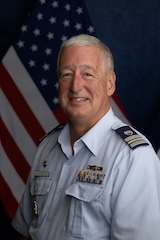Return to R-Directorate's Home Page.
AUXAIR is an Auxiliary operational program, organized on a district level rather than on a flotilla and division basis. AUXAIR aviators have varied aviation backgrounds and many have prior military experience. AUXAIR aviators volunteer their aircraft for use as facilities, just as surface operators volunteer their boats.
All Auxiliary aircraft meet strict U.S. Coast Guard and Federal Aviation Administration requirements.
Missions
AUXAIR participates in many Coast Guard missions including:
- Search and Rescue,
- Ports,
- Waterways and Coastal Security,
- Marine Safety,
- Pollution Response,
- Aids to Navigation, and
- Ice Reconnaissance.
It also conducts Logistic Transport Missions. AUXAIR is an integral part of the Coast Guard search and rescue team and its homeland security forces.
As with surface operators, air facility operators are issued patrol orders. Orders are issued based on schedules created by crew and facility availability and the needs of the Coast Guard. Coast Guard Air Stations are the Order Issuing Authority for AUXAIR. This alignment of Auxiliary aviation assets in a district with an Air Station is known as the “squadron concept”, because aviation orders and direction flow directly between the Air Station and the district aviation staff.
Auxiliarists involved in AUXAIR take Auxiliary aviation training, completing the syllabus for their level of qualification. After having their knowledge and skills approved by an Auxiliary Flight Examiner, they may be certified by the District Director of Auxiliary (DIRAUX) as Pilots, Observers or Air Crew in the AUXAIR Program.
![]()
Pilot Qualifications
There are three qualification levels for pilots, similar to active duty Coast Guard:
- Aircraft Commander,
- First Pilot, and
- Co-Pilot.
Minimum requirements for the different levels for pilots are measured by Pilot in Command time and are:
- 1000 hours with an Instrument Flight Rules (IFR) rating for Aircraft Commander,
- 500 hours for First Pilot, and
- 200 hours for Co-Pilots.
These levels of pilot qualification are also linked to the types of missions they are authorized to fly. All pilots must pass recurrent flight checks and undergo annual safety training.
AUXAIR does not offer flight training for pilots. Rather, it builds on what certificated pilots already have learned. Pilot applicants learn about search and rescue (SAR) techniques and patterns, Coast Guard communications, and Coast Guard flight safety rules and procedures.
Pilot candidates must successfully pass a written open book test, take water survival training and pass a check flight. Auxiliary aviators are held to high standards of training and safety. Auxiliary pilots are Pilots-in-Command of each mission.
![]()
Non-Pilot Crew Positions
Non-pilot crew positions include Observer and Air Crew. Observers must pass air operations training and egress/water survival training. Air Crew are observers with additional training and qualifications. Observers generally handle communications between aircraft and Coast Guard units, assist the pilot with navigation, keep records in the air, and focus their attention outside while searching. Observers are the payload for search missions. AUXAIR can not perform most missions without the Observer.
Observer training includes:
- aviation orientation,
- observation techniques,
- communications,
- search techniques and patterns, and
- safety and survival skills.
Observer candidates must successfully pass a written open book test, take water survival training, and gain experience in the air on missions, then demonstrate their skills to a First Pilot or Aircraft Commander.
Experienced Observers may be eligible to earn the Air Crew rating. The training for the Air Crew rating rounds out the Observer's knowledge with more instruction on:
- aviation and aircraft operations,
- crew resource management,
- aviation communications, and
- navigation procedures.
Candidates for Air Crew pass a physical exam, learn the contents of the Air Crew Training Syllabus, are trained and examined on that material by Instructor Pilots and Flight Examiners and, if successful, are certified by the Director of Auxiliary. All flight crew members (including all Observers, Air Crew, and all pilots) must have annual emergency egress training and water survival training. This includes a 75-yard swim, life raft and emergency gear familiarization, and may include optional training in the SWET – Shallow Water Egress Trainer.
AUXAIR training is ongoing, with aviation training workshops held at least annually. Recurrent training is conducted in Crew Resource Management (CRM), aviation decision-making, risk management, aero-medical topics, Federal Aviation Regulations (FARs), and general aviation safety topics. AUXAIR patrol and administrative topics are included as well.
Operational Facilities
Pilots may offer their aircraft for use as Coast Guard Auxiliary operational facilities. Planes are inspected to verify that they meet requirements and that all paperwork is in order. A marine radio must be available for use in the plane and an external antenna must be installed. All aircraft used in AUXAIR operations must be USCG approved facilities. Auxiliarists using their own aircraft on ordered missions may be eligible for reimbursement for fuel and maintenance expenses.
Currency Maintenance
Currency maintenance insures that members maintain their proficiency and ability to safely perform their duties.
Orders - Authorization for Patrols
Orders for facility movement, whether for vessel or aircraft movement, or radio facility activation and/or movement is one of two general kinds of orders that may be issued to Auxiliarists. Such orders are considered "assignment to duty". These orders may be either written or verbal, and may be reimbursable or non-reimbursable. Auxiliarists may not use any facility or special purpose facility for any Coast Guard or Coast Guard Auxiliary purpose or mission unless appropriate patrol orders have been issued and the facility has been properly offered and accepted for use. An Order Issuing Authority (OIA) must issue or authorize orders before an Auxiliarist conducts any patrol activity.
